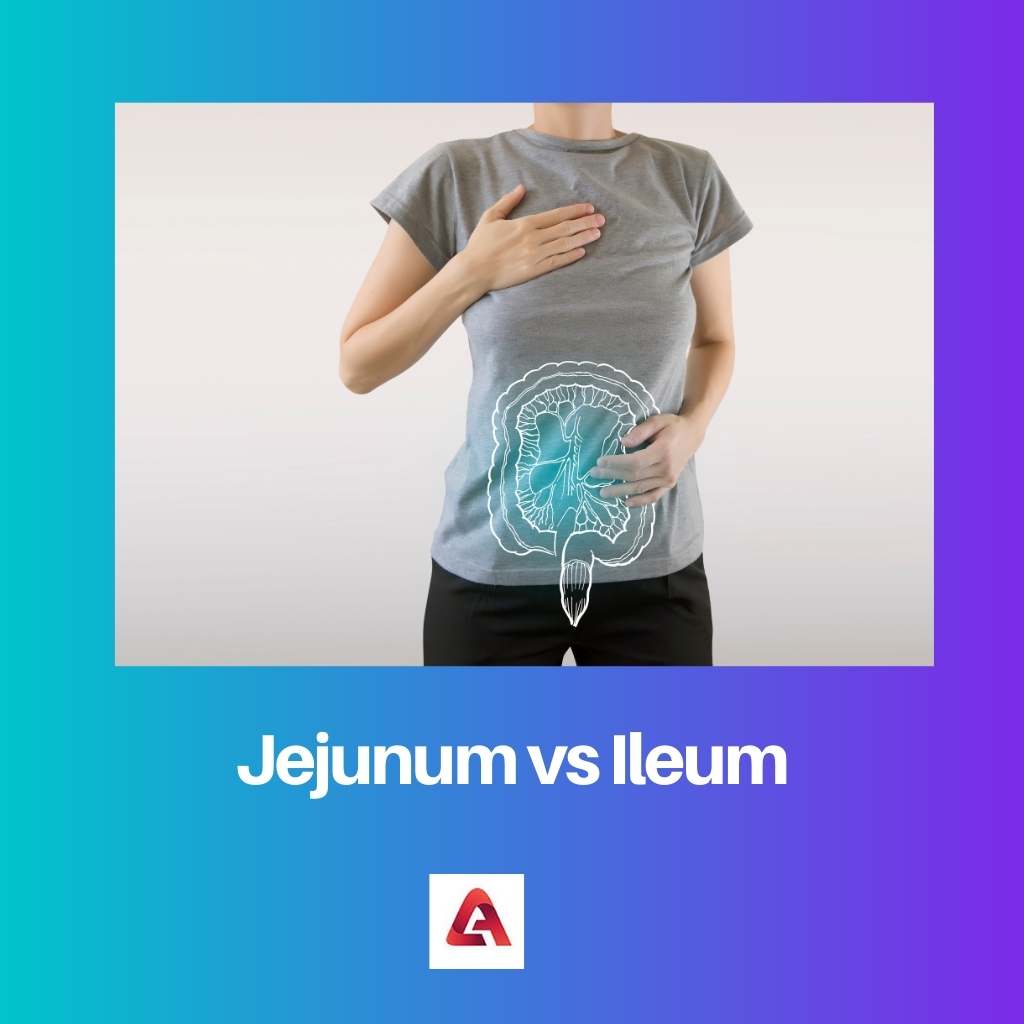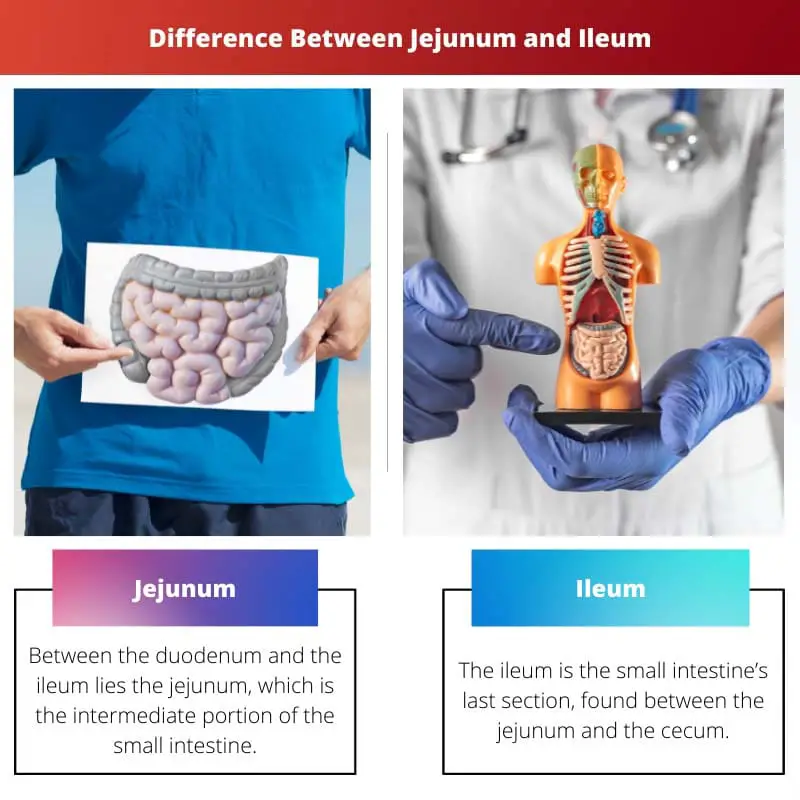The jejunum and ileum are the two bottom parts of the small intestine. The small intestine is a component of an animal’s alimentary canal that is primarily responsible for nutrition absorption.
In addition to absorption, the small intestine also undergoes mechanical and chemical digestion.
There is no natural distinction between the jejunum and the ileum. However, there is a distinction between the jejunum and the ileum.
Key Takeaways
- The jejunum and ileum are both parts of the small intestine.
- The jejunum is located closer to the stomach than the ileum.
- The ileum is responsible for absorbing vitamin B12 and bile salts.
Jejunum vs Ileum
The difference between jejunum and ileum is that jejunum absorbs completely digested carbs and proteins, whereas ileum absorbs non-absorbed jejunum particles. The jejunum is the middle portion of the small intestine, on the other hand, the ileum is at the end. Compared to the jejunum, the ileum has more arterial arcades (p 0.0001) and arteriae recta (p = 0.02).

Between the duodenum and the ileum is the jejunum, which is the intermediate section of the small intestine. It begins on the left side of the second lumbar vertebra at the duodenojejunal flexure.
It measures 2.5 meters in length and 2.5 centimetres in diameter in an adult person. The walls of the jejunum are thicker, with more villi and plicae circulares.
Between the jejunum and the caecum is the ileum, the final and longest part of the small intestine. It is around 2 to 4 m long and 2 cm broad.
The ileocecal valve is the valve that links the ileum with the caecum. Ileum has a thinner wall and a narrower lumen. It is primarily responsible for the absorption of vitamin B12 and bile salt.
Comparison Table
| Parameters of Comparison | Jejunum | Ileum |
|---|---|---|
| Definition | Between the duodenum and the ileum lies the jejunum, which is the intermediate portion of the small intestine. | The ileum is the small intestine’s last section, found between the jejunum and the cecum. |
| Width | <3 cm. | <2 cm. |
| Function | Absorbs carbs and proteins that have been fully digested | absorbs the jejunum’s non-absorbed particles |
| Folds | Approximately 2-3 mm thicker. | Less than 1-2 mm thick. |
| Beginning | The jejunum’s suspensory muscle. | The start is unknown. |
What is Jejunum?
The jejunum is the small intestine’s middle section between the duodenum and the ileum. As a result, it is located in the centre of the small intestine.
The jejunum is around 8 feet long in adults. It all starts with the suspensory muscle of the duodenum.
The jejunum, like the other two segments of the duodenum, is covered with mesentery, a thin membrane that keeps the small intestine warm.
The jejunum’s primary role is to absorb nutrients. As a result, it has villi and microvilli on the jejunum’s interior wall.
The jejunum absorbs carbs, proteins, lipids, minerals, and electrolytes. The huge number of blood veins supplying the jejunum gives it a crimson appearance.
The mesentery, like the ileum, is an organ that supports and holds it in place in the abdominal cavity.
The contents of the stomach pass through the duodenum before entering the jejunum, with the aid of pancreatic enzymes and bile generated by the liver. About two-fifths of the small intestine is made up of the jejunum.
The blood flow is carried by around 5 jejunal arteries connected to the other small intestinal arteries by many arcades. Through the corresponding veins, venous blood flows into the superior mesenteric vein.
The jejunum has several folds.
What is Ileum?
The ileum is the small intestine’s last portion, lying between the jejunum and the caecum. It is 11.5 feet long.
The ileocecal valve directs the ileum’s contents into the cecum. The ileum’s wall is thinner than the walls of the other portions of the small intestine because it contains a thin, smooth muscle layer.
Small collections of lymphatic tissues known as Peyer’s patches can be seen in the ileum’s wall.
The ileum has specific receptors for vitamin B12 absorption as well as receptors for bile acids.
The jejunum possesses minor levels of Mucosa Associated Lymph Tissue (MALT), but the ileum is found to have vast quantities of MALT in the form of Peyer’s patches.
The Peyer’s patches are made up of these two kinds of receptors. The ileum absorbs the majority of conjugated bile acids.
The ileum’s vascular arcades are substantially shorter and shallower than the jejunum’s. The precise causes of such disparities are unknown.
The mesentery binds the ileum to the abdomen’s posterior wall, thus it sits loosely in the abdominal cavity.
The ileum is supplied with arterial blood by around twelve ileal arteries, known as straight arteries.
The ileum’s main roles include nutritional cleavage by enzymes, vitamin B12 absorption, lipid and bile salt absorption, and immunological activity.
Main Differences Between Jejunum and Ileum
- The small intestine’s middle section. It’s located between the duodenum and the ileum. The jejunum aids in the digestion of meals from the stomach, whereas the small intestine’s last section. It is linked to the cecum. The ileum aids in the digestion of food that has passed through the stomach and other portions of the small intestine.
- The jejunum is somewhat broader (3 cm) than Ileum, which is just 2 cm wide.
- Jejunum absorbs completely digested carbs and proteins, whereas Ileum absorbs non-absorbed jejunum particles.
- The folds of the jejunum are 2-3 mm thicker, whereas the folds of the ileum are 1-2 mm thicker.
- The jejunum’s suspensory muscle identifies the jejunum’s start, but the ileum’s exact start is unknown.



